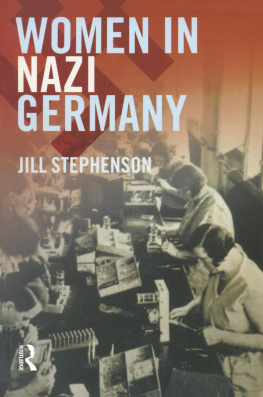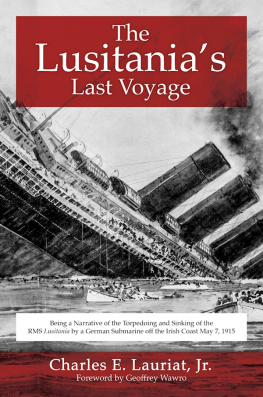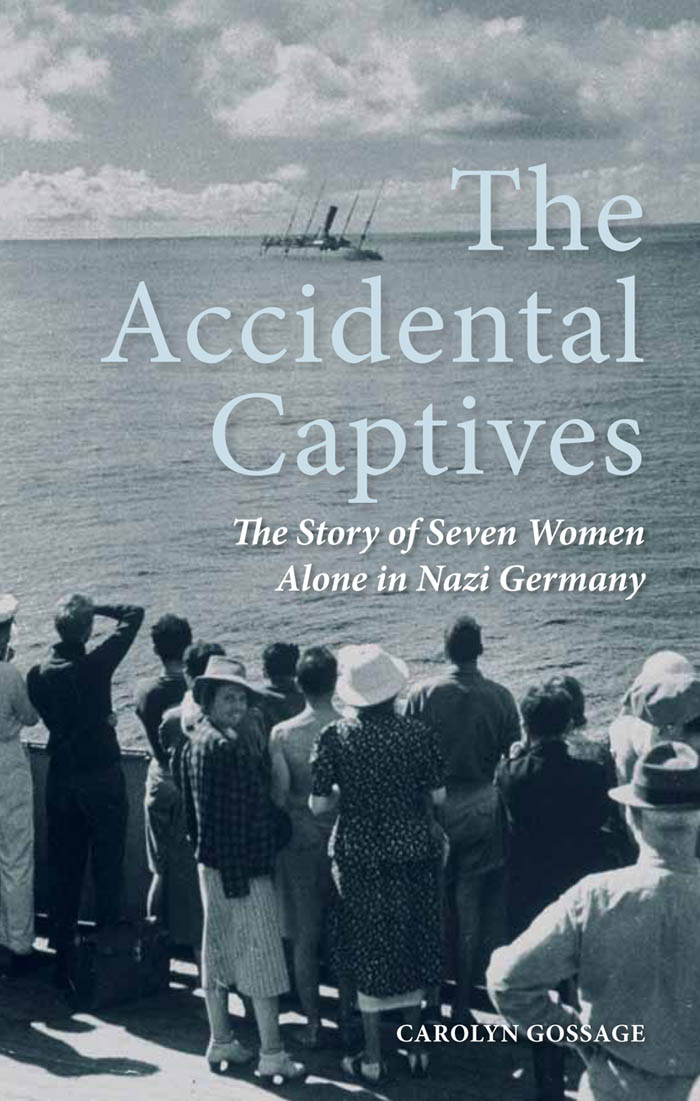The Accidental Captives
History is about building bridges between the past and the present, observing both banks of the river, taking an active part on both sides
Bernhard Schlink, from The Reader, 1997
The Accidental Captives
The Story of Seven Women Alone in Nazi Germany
Carolyn Gossage
With the co-operation of Peter Levitt

DUNDURN
TORONTO
Copyright Ch. Links Verlag, Berlin, 2009, 2012
This English-language edition was first published by I.B.Tauris & Co Ltd in the United Kingdom.
All rights reserved. No part of this publication may be reproduced, stored in a retrieval system, or transmitted in any form or by any means, electronic, mechanical, photocopying, recording, or otherwise (except for brief passages for purposes of review) without the prior permission of Dundurn Press. Permission to photocopy should be requested from Access Copyright.
Library and Archives Canada Cataloguing in Publication
Gossage, Carolyn, 1933
The accidental captives: the story of seven women alone in Nazi Germany / written by Carolyn Gossage.
ISBN 978-1-4597-0362-9
1. Women prisoners of war--Canada. 2. Women prisoners of war--Germany. 3. World War, 19391945--Prisoners and prisons, German. 4. World War, 19391945--Prisoners and prisons, French. 5. World War, 1939-1945-Women. I. Title.
D805.G3G68 2011 940.547243082 C2011-905554-6
1 2 3 4 5 15 14 13 12 11

We acknowledge the support of the Canada Council for the Arts and the Ontario Arts Council for our publishing program. We also acknowledge the financial support of the Government of Canada through the Canada Book Fund and Livres Canada Books, and the Government of Ontario through the Ontario Book Publishing Tax Credit and the Ontario Media Development Corporation.
Care has been taken to trace the ownership of copyright material used in this book. The author and the publisher welcome any information enabling them to rectify any references or credits in subsequent editions.
J. Kirk Howard, President
www.dundurn.com
Dundurn
3 Church Street, Suite 500
Toronto, Ontario, Canada
M5E 1M2 |  |
Contents
1 The last voyage of the Zamzam
20 March17 April 1941
2 Prisoners of war on the high seas
18 April20 May 1941
3 Overland into the Third Reich
21 May15 June 1941
4 Liebenau internment camp
16 June13 September 1941
5 Stranded in Berlin
14 September 194112 June 1942
6 Repatriation
1330 June 1942
Preface and acknowledgements
This book owes its genesis to a chance discovery made over twenty years ago in the Metro Toronto Reference Library. I was sifting through the librarys card catalogue researching another project entirely when I stumbled upon Free Trip to Berlin, published in Canada in 1943.
The books unusual title immediately caught my attention, and once I had a copy in my hands it was a matter of minutes before I was irrevocably drawn into this extraordinary and fascinating story. Almost certainly this was largely due to the authors distinctive style. Isabel Russell Guernsey was clearly a woman of exceptional intelligence, wit and charm, whose irrepressible joie de vivre reverberated through the decades since the publication of her book.
In April 1941, Isabel Guernsey was a passenger on board the Zamzam, an Egyptian liner sailing from New York Harbour to Cape Town, when the ship was attacked and sunk by a German raider in the South Atlantic. The Zamzams two hundred passengers were literally fished out of the water by the crew of the raider and transported via a German prison ship to Vichy France. Here the majority of them as neutral citizens of the United States were then released, while the remaining passengers were transported to the Third Reich as prisoners of war. Among these were 28 women and children who were citizens of either Great Britain or British Commonwealth countries including Isabel Guernsey and a number of other Canadians who were dispatched by train through German-occupied France and zigzagged their way through Nazi Germany before arriving at Liebenau, an internment camp in the vicinity of Lake Constance (the Bodensee), near the Swiss border.
Three months later, seven of the Canadian women who had been passengers on board the Zamzam received permission to leave the camp and travel unescorted to Berlin, where they held high hopes that arrangements for their safe return to Canada could be made within a matter of weeks. Instead, before their exchange for an equal number of German women in Canada was finally realised, they remained stranded in Berlin for the better part of a year.
By the time I closed the covers of Isabel Guernseys book, I realised that I had unwittingly fallen under its spell. What an intriguing story and what an incredible journey! I was consumed with curiosity, but soon realised that I was also left with more questions than answers. Isabels account concentrated primarily on her recollections of the people she came to know during her stay in Germany, whereas her impressions of the six Canadian women who shared the same experience remained on the periphery. Isabel herself mentions this disparity in her foreword to Free Trip to Berlin. I regret that my Zamzam companions appear so incidentally in these pages, which is a pity, since each one is a story in herself This is a story mostly about people people I met and grew to know in Germany. My hope is simply that they, through me, may shed a little light that hasnt been shed before.
I, too, found myself equally disappointed that her companions in adversity were mentioned only in passing. Dozens of beguiling questions had already begun to surface and percolate in the back of my mind. Who were these six other Canadian women who had been thrown together by fate and circumstance as Isabels companions on this 1941-42 wartime odyssey that ended with them being marooned in Berlin? Vida Steele from Three Hills, Alberta, Olga Guttormson of Naicam, Saskatchewan, Allison Jamie Henderson of Winnipeg, Manitoba, Katharine Kitsi Strachan and Doreen Turner from Toronto and Clara Guilding, formerly of Toronto. Why had they chosen to leave the safety of home to risk a four-week Atlantic crossing fraught with uncertainty and danger? How had they reacted both individually and collectively to the countless difficulties they encountered on their long and wearisome odyssey? And after spending more than a year in Nazi Germany, initially as civilians detained in a variety of jails, then an internment camp and later as enemy aliens at large in Berlin, how had they dealt with the challenges of fending for themselves and organising their lives in the war-torn capital of the Third Reich?
In retrospect, it must have been at precisely this moment that I realised that sooner or later I would have to try to find answers to these and other enticing questions in order to record my own expanded version of this long-forgotten and little-known World War II episode.
When their ship was sunk from under them in the South Atlantic by the












